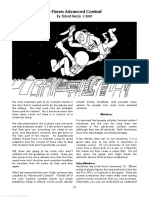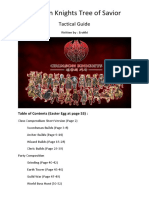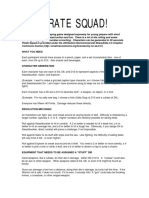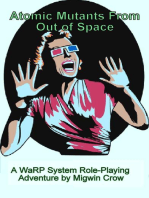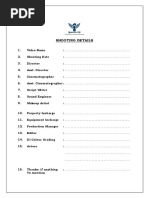Clay-O-Rama: A Miniatures Melodrama For All Ages
Clay-O-Rama: A Miniatures Melodrama For All Ages
Uploaded by
Tim SniderCopyright:
Available Formats
Clay-O-Rama: A Miniatures Melodrama For All Ages
Clay-O-Rama: A Miniatures Melodrama For All Ages
Uploaded by
Tim SniderOriginal Title
Copyright
Available Formats
Share this document
Did you find this document useful?
Is this content inappropriate?
Copyright:
Available Formats
Clay-O-Rama: A Miniatures Melodrama For All Ages
Clay-O-Rama: A Miniatures Melodrama For All Ages
Uploaded by
Tim SniderCopyright:
Available Formats
CLAY-O-RAMA
A miniatures melodrama for all ages
by David Zeb Cook
The Giant Blue Bowling Bail slowly roiled across the
battlefield toward the Neon Orange Thing with the big
floppy mouth and writhing mass of tentacles. Desperately, the Neon Orange Thing hurled pellets at the ball
as it came relentlessly forward.
Then there was a flash, and a Four-Legged Red Jet
plowed into the rear of the Bowling Ball, cracking the
balls surface. The Neon Orange Thing, sensing a kill,
closed in. Panicked, the Bowling Bali whipped around,
flattening one of the wings of the Red Jet. The Orange
Thing lashed out with its tentacles, grasping the ball
firmly. With a mighty heave, the Orange Thing hurled
the Bowling Ball into the air. It sailed up and hurled
down, splitting into pieces as it hit the ground.
Turning from the destruction, the Red Jet grinned as
it sighted the Orange Thing. Feeling lucky today? it
asked and charged.
Such are the adventures of the denizens of Claydonia as they meet on the battlefield of Clay-O-Rama.
Now you, too, can recreate their epic struggles, in
the all-new, home-use Clay-O-Rama Miniatures Rules
the same you see used every year at the
GEM CON Games Fair!
DRAGON 51
What is a Clay-O-Rama?
A Clay-O-Rama is many things. It is a
chance for friends to meet and have a
good time. It can be a serious philosophical
discussion on the meaning of modeling
clay. It is a means of artistic expression. It
is a ritualistic gathering of Claydonians to
watch the violent destruction of others of
their species. But, most of all, it is a silly
game involving modeling-clay miniatures.
What do I need to have a Clay-ORama?
First, you need a group of people willing
to be silly and have fun playing with modeling clay. Next, you need these rules or something like them. Then, you need pencils,
paper, and numerous six-sided dice for each
player. Finally, you need one can of modeling
clay for each player. Utterly unscientific
testing has shown that PLAY-DOH Modeling
Compound is well suited for use in a Clay-ORama. It is easily shaped, comes packaged in
the proper amounts, and has pleasing, brilliant colors.
How do I create a Claydonian?
After you have assembled the items
listed above, find a large smooth space on
which to play. This could be several tables
pushed together or a smooth tile floor. Do
not play in a place where you do not want
to have bits of modeling clay about. After
you have found a place to play and have
assembled your friends, give each one a
can of modeling clay. Try to let each player
have the color he or she wants. After
giving out the clay, tell the players the
following:
You have twenty minutes in which to
make a creature out of your modeling
clay. You may create anything you
want, so long as it does not collapse at
the slightest touch. You do not have to
use all of your clay; any clay you do not
use may be shaped into missiles of any
size and shape you want. You may not
trade clay with another player; use
your own clay. When you have finished
making your Claydonian, let me know.
After telling your players this, let them
go to it. Do not tell them any more about
what will happen except that it will be a
miniatures game. Encourage creativity. As
each player finishes his or her creation,
you must assign the creation its powers.
How do I assign powers?
There are six categories of powers that
must be assigned to each Claydonian:
movement, number of attacks, to hit
number, damage, hit points, and special
powers. Each one requires that you make
a judgment about the creation of the play
er. The following are guidelines for assign
ing the powers; you may alter them as you
see fit.
Movement: All movement is measured
in spans of the players outstretched hand
(from tip of thumb to tip of little finger).
The following table gives the basic movement rates.
Number of legs
0
1-2
3-4
5 or more
Movement
1 span
2 spans
3 spans
4 spans
Note that a leg is any type of
movement-producing appendage the
Claydonian might have, even if it is a
wheel.
Number of attacks: Look at the creation carefully. How many limbs can it use
for attacking? This is the number of
attacks it can make each turn. However,
this number should never be more than
four.
Chance to hit: A Claydonians basic
chance to hit is 8 or greater on two sixsided dice. If the creature has big limbs or
a big mouth, the chance to hit is reduced
by one. If the creature has real big limbs
or mouth, or it uses its entire body in an
attack, reduce the chance to hit by two.
You decide just how big is big or real
big.
Damage: The base damage done in any
attack is one six-sided dies worth of
points. If the limbs are large, one to two
more dice may be added to this. If the
limbs are very large, three more dice may
be added. If the attack is an absolute killer,
up to five dice may be added to the base
attack die. As usual, you can decide all
final attack values. If youre getting the
idea that this is not a very exact game, you
have the right idea. Youre playing with
clay monsters, right? Who needs to be
exact?
Hit Points: Look at the creature and
compare it to the amount of clay kept
aside to use for missiles. If the entire can
of clay was used to form the creature, it
has 50 hit points. If half was used for
missiles, the creature will have 25 hit
points. Assign hit points based on the
fraction of clay used to form missiles. If
25% of the clay is used for missiles, knock
25% off of 50 to find the creatures hit
points, This is another judgment call on
your part as the referee.
Special Powers: Each creation gets
one special power. It may be from the list
below, or it can be one you make up. If
you make it up, it is recommended that
you create a power that will affect modeling clay in some harmless way. The following powers may be assigned randomly by
rolling a die or may be chosen by you to
match the creature in some way.
1. The Drop: Made in place of one normal attack. If a hit is successfully made,
you then lift the target into the air and
drops it 3. Afterwards, you can decide the
amount of damage caused based on what
happened.
2. The Bowl: This power works like the
drop, except that you roll the target across
the battlefield.
52 SEPTEMBER 1987
OFFICIAL CLAY-O-RAMA RULES
3. The Poke: When a hit is made, you
poke the target hard with your finger,
making a nice hole in it. Then you decide
the amount of damage.
4. Reshape One Limb: This power is
used in place of a normal attack. If it hits
successfully, the attacking player may alter
the shape of any one limb of the target as
he pleases. As referee, you should be
ready to assign damage or altered powers
because of this change.
5. The Blob of Death: This power may
only be used by a creature with missiles.
The player may designate one of the missiles to be his Blob of Death. It is fired like
a normal missile (see How does my
Claydonian shoot?). If it scores a hit, you
should take your fist and give the target
one solid smash to show the effects of the
missile. After doing this, assign damage
based on the consequences. Only one Blob
of Death per game is allowed.
6. Rip Limbs Off: When the creature
rolls an 11 or 12 on a normal attack, the
player may tear one of his opponents
limbs off. Ah, that is, the player may tear
off one of his Claydonians opponents
limbs. Though this attack causes no damage to the target in terms of lost hit points,
you should be ready to note any changes
to the targets powers.
7. Change Places: In addition to a normal
attack on a successful hit, creatures with
this power may change places with any
opponent on the board, or may change the
places of any two other creatures on the
board. The creature may not move in the
same turn it uses this power.
8. Move Out of Turn: Creatures with this
power may move at any initiative point in
the turn. They simply announce that they
wish to move. They may not move in the
middle of another players move.
attacker wants to do so. The decision must
be made immediately or the borrowed
power will be lost until another successful
hit is made. The player with this power
should not be told what the powers of
other creatures are; he can only learn this
by observation.
You may create any other powers you
can think of. However, be sure that none
of them are dangerous to the players or
any spectators watching the game.
How do I play the game?
Once all the players have created their
Claydonians and have had powers
assigned to them, have them gather
around the playing area. Have the players
space themselves at equal distances from
each other. Each player should then roll
three six-sided dice to find his or her
initiative number. Ties should be rolled
off. Be sure each player notes his initiative
number. After this is done, explain the
What Do I Do, How Do I Move, How Do I
Shoot, How Do I Attack, and How Do I
Win rules to the players. Once everyone
understands what is going on, begin the
game.
What do I do?
The Clay-O-Rama is played in turns. A
player gets to move his creation once
during each turn. At several points during
a turn, a player may have the opportunity
to attack. Each player takes his move in
the order of the initiative rolls, going from
highest to lowest. The sequence of a
players move is as follows:
1. Move your creation up to its full
movement.
2. Fire up to three missiles at targets of
your choice.
3. Attack any creature to which your
Claydonian is adjacent, provided you have
attacks left to do so.
4. The other player (or players) may
counterattack against your creature, provided they have any attacks left.
Each player follows this sequence, in
order of initiative, until the player is out of
the game or the game is over.
How does my Claydonian move?
To move your creation, use your hand to
measure the distance the Claydonian
moves, starting from the front of the
creature. If there is no discernible front,
begin measuring in the direction the creature last moved. There is no terrain in the
game (though you can add some if you
like). Thus, except when turning, a creature will always be able to move up to its
full movement.
Note that if some people feel that the
hand-span measuring system is unfair or
grossly inaccurate, you may then enforce
the Uniformity Rule. The Uniformity Rule
states that all distances will be measured
by the referees hand. However, this will
slow down the play of the game and place
a great deal of work in the hands of the
referee (ahem).
If a part of a creation comes off during
movement, the player is allowed to put
that piece back on his creation at no penalty. Falling apart is best done under combat
conditions.
How does my Claydonian shoot?
At the end of movement, each player is
allowed to shoot up to three of his missiles. A missile may only be used once.
After it is fired, it is removed from play. If
a player does not have any missiles, he
may not fire any.
9. Use Opponent as Missile: If all of an
attackers limbs hit a target, he may pick
his target up and use it as a missile against
a third opponent. The missile is fired
normally, and you as referee should assess
damage to both the missile and the target.
10. Divide Self: This power should only
be given to creatures that can easily divide
into two sections. Each half has half the
powers of the normal creature at the time
of division.
11. Borrow Power: In addition to all
normal attacks, a successful hit by this
creature allows it to use the special power
belonging to the creature it hit, if the
DRAGON 53
OFFICIAL CLAY-O-RAMA RULES
To fire a missile, the player stands anywhere within 3-4 of his own position at
the table. The player may not move to a
different area of the battlefield; he must
fire his missiles from the point where his
creation began the game. After the player
has his position, have him name his target
(a specific Claydonian creation on the
table). Players cannot attack a group of
monsters; only one will do.
Have the player throw his missile,
attempting to hit the target. Make it clear
to the thrower that how hard the missile
is thrown has NO effect on the amount of
damage done. It is only the SIZE of the
missile that matters. It is a wise idea to
have someone stand directly opposite the
thrower to catch long shots and bounces.
If the thrower manages to hit his declared
target, the missile has hit. If the thrower
hits a different creature, the shot is a miss,
no matter what happens. The attacked
player is allowed to reattach any parts of
his Claydonian that come off due to the
missiles hits, unless a special power dictates otherwise. If the missile missed, the
shot is no good.
If a missile hits its target, you must
determine the amount of damage done by
the missile. The base damage for a missile
is one six-sided die for something about
the size of a marble. Missiles smaller than
this may do less damage. Missiles larger
than this should do proportionately
greater damage (up to five dice).
How does my Claydonian attack?
Each Claydonian is assigned a number of
attacks it can make in one turn, based
upon the number of manipulative limbs it
has. These attacks can be used as attacks
or counterattacks. If a creation has used
all its attacks, it may not make any more
attacks (or counterattacks) for the rest of
the turn.
If your creation is adjacent to an enemy
creation, you may decide to attack. Adjacent is defined as being within the reach
of your creations arms. You may attack as
many times as you have attacks, provided
you have not used any of your attacks to
make counterattacks (see below).
To make an attack, you must announce
your target and the dice of damage done
by the attack (unless all of your attacks do
the same amount of damage). Then roll
two dice. If the dice roll is equal to or
greater than your to hit number, you
have hit your target with that attack.
After all attacks have been resolved
against one target, count the number of
dice of damage from all those successful
attacks. Roll the dice and add them together to find the total amount of damage
caused. The player whose creature was
the target of the attack should subtract
this amount from his creations hit points.
If the creations hit points reach zero, the
creation is dead (see below on what happens then).
How does my Claydonian counterattack?
A Claydonian may counterattack if it is
attacked by another creation during the
combat phase. To counterattack, the
Claydonian must have a few attacks left
and must survive the attacks of its opponent. It may only make attacks against the
creation that just attacked it. The counterattacks are handled as if they were normal
attacks. A Claydonian may use its special
power in a counterattack.
What happens when my Claydonian
dies?
Ah, this particular question has plagued
the Claydonian philosophers for centuries.
Several scurrilous theories have been
presented, including the concepts of drying out or being eaten by small children
and dogs. However, in watching the deaths
of several Claydonians on the field of
battle, a common belief has arisen. Most
Claydonians feel that when one of their
kind dies, a large hand reaches from the
heavens and squeezes the Claydonian
through its fingers. This act is almost
always accompanied by a horrible scream
that echoes through the heavens.
How do I win?
This depends on why you are playing
this game in the first place. If you are
playing to have fun, you win if you get
really silly. If you are playing to be competitive and to beat out everyone else, you
win if your creation is the last surviving
Claydonian on the battlefield. Since only
one person can win the second way, its a
lot nicer to play for the first reason.
These are the rules for the Clay-O-Rama.
Take them, have fun with them, be
inspired to the heights of silliness, or feed
them to your dog. Enjoy!
PLAY-DOH is a registered trademark of Kenner
Parker Toys Inc.
54 SEPTEMBER 1987
All is quiet on the battlefield as the two opponents
take their places. Smoof, the gourd-shaped clay
thing, looks malevolently at his opponent, the fourarmed,six-legged, multi-colored monster called
Creepy even by his mother. Creepy is the reigning
Clay-O-Rama champion, having beaten 15 opponents and eaten 10 of them. Smoof is his next meal
er, opponent.
Creepy suddenly moves forward and shoots three
square orange things at Smoof; two of them hit. The
angry Smoof propels himself at the monster, but
Creepy bites Smoof and hits him twice. Wounded,
Smoof teleports himself to the opposite side of the
game area. Creepy lets out an evil laugh and teleports
next to Smoof. Too bad, sucker! hisses Creepy as he
kills Smoof and proceeds to add him to his body. Sated, Creepy shouts in triumphbut is destroyed by
an angry art teacher.
28 APRIL 1989
the world of Clay-0-Rama in DRAGON
issue #125, I immediately went out and
bought half a dozen cans of Kenners
PLAYDOH Modeling Compound. Some
demented friends of mine came over, and
we threw colored clay at one another. I
was immediately hooked. I loved this new
pastime but felt that something was missing from the game. After eating a cheese
cake, drinking two liters of Cherry 7-Up,
and watching Sesame Street reruns, I
came to the following conclusions: one,
there is no black PLAY-DOH compound;
and two, being a lover of the AD&D
game, I was disappointed to find that the
Clay-O-Rama rules offered no way to
advance your Claydonians or conduct
ongoing campaigns.
Consequently, I was motivated to write
additional rules for the game, for my
friends and my own personal use. Every-
thing was great, except for the additional
amount of clay stuck in my hair and the
fact that my favorite Claydonian was
baked to a crisp by someone who failed to
see the humor in my using three-inch
steelies as Claydonian ammo. As the days
went on, I added more powers to the list.
This is how my Claydonian saga began.
Campaign rules
Players who win Clay-O-Rama game
sessions may wish to keep their Claydonians and use them in future game ses-
sions. A long-lived Claydonian deserves
some reward for surviving these silly
battles. The campaign rules additions are
explained as follows:
Experience level: This is just a power
ranking created to satisfy a Claydonians
ego. Table 1 provides level numbers, level
titles, and additional benefits. The level
number corresponds to the number of
powers a Claydonian has. All Claydonians
begin at first level with one power. As they
defeat enemies (i.e., anyone they can flatten), they rise in level and gain more hit
points. The hit points are cumulative
(unlike powers); thus, by fifth level, a
Claydonian would have 65 hit points add-
ed to its original score. By sixth level, the
Claydonian has become too powerful to be
fun and it ceases to enjoy life, thus dying
of old age (or drying out, whichever
comes first). Of course, in your campaign
Claydonians may be immortal. Ill leave it
up to you, but I wouldnt worry about it
anyway. Ive never had a Claydonian live
to see third level, much less sixth.
DRAGON 29
Table 1
Claydonian Level Advancement
Number of
enemies
destroyed or
defeated
0-5
6-15
16-30
31-50
51-80
81
Experience
level
1
2
3
4
5
6
Title
Silly Thing
Weirdo
Freak
Kook
Blob Monster
Supreme Slime
Table 2
Teleport Direction
1d6 roll
1-2
3
4-5
6
Direction
North
West
South
East
Taking the same power twice: If a player
opts to take the same power twice, the
effects of that power are doubled. For
example, if a Claydonian takes Regeneration twice, its regains 2-12 instead of l-6
hit points each turn. A Claydonian with
Absorb Opponent taken twice cuts the to
hit number it needs by half (round fractions up) when applying this power.
Claydonians can also triple their powers,
but this may make such Claydonians
unfair opponents when certain powers are
thrice increased.
Regaining lost hit points: During a game
session, a Claydonian cannot regain lost hit
points without the power of Regeneration.
At the end of the game, however, the
surviving Claydonian (or Claydonians, if
youre playing in teams) regains all lost hit
points, and all sustained damage is
repaired.
Benefits
1 power
2 powers, +5 hit points
3 powers, + 10 hit points
4 powers, +20 hit points
5 powers, + 30 hit points
Claydonian dies of old age
regain all lost missiles at the end of a game
and can take all of the losers missiles, too.
Reshaping: At the end of a game session,
a Claydonian can be reshaped with the
following restrictions:
1. No new missiles may be made.
2. Missiles may not be added to body
mass.
3. The number of limbs used for attacking may not exceed four.
4. The Claydonians powers may not be
changed.
Death: When a Claydonian reaches sixth
level or is defeated (i.e., killed), it is recycled by the gods. If a Claydonian dries up,
it is dead. Favored Claydonians should be
lovingly zip-locked in a damp bag, kept
cool, and guarded carefully. Enemies have
been known to microwave their opponents for revenge; in extreme cases, angry
opponents have been known to use various torture machines, such as the PLAYDOH Barber Shop and the PLAY-DOH Fire
Engine. If consumed by a dog or small
child (PLAY-DOH is nontoxic), a Claydonian
is considered dead. Note that dried Claydonians may sometimes be revived by adding
water, if rescued in time.
No referee rules: To eliminate a referee
from the gaming environment, Clay-ORama players may lock him out of the
room. There is, however, an easier way:
Simply have everyone play a Claydonian.
players not involved in the dispute make
the final decision. Another system is to
have a referee who plays and referees at
the same time. This referee makes all
decisions on damage and such except
when his Claydonian is involved (players
not involved in the disagreement make the
decision in this instance). In a two-player
game, problems are resolved by smacking
the other persons Claydonian before he
can get to yours.
Silly Putty: This is a new type of material
for creating Claydonians. No one knows
for certain where this strange material
came from. Some say it is a gift left by an
extraterrestrial intelligence, and some say
it came from across the rainbow. I say its
radioactive jelly. One thing is for sure: Silly
Putty makes nifty Claydonians and adds a
new dimension to Clay-O-Rama battles.
Although it doesnt come in the pretty
colors that PLAY-DOH compound does,
with Silly Putty, you can put the face of
your favorite cartoon character on your
Claydonian. But dont let your fun turn
into a political argument, as once happened when a player put Ronald Reagan
on his Silly Putty creature and said that he
couldnt be defeated because he was President (the problem was settled when someone threw the Putty Reagan down the
garbage disposal). You should note, however, that Silly Putty doesnt mix well with
clay or PLAY-DOH compound. As a result,
clay characters with the Absorb Opponent
or Absorb Missile powers may have trouble absorbing Silly Putty.
A sticky situation: What do you do if a
missile or other object sticks onto a
Claydonian? Well, you pry it off, of course.
Note, however, that the Claydonian then
takes damage amounting to half the total
caused by the object (e.g., a missile hits a
Claydonian for 4 hit points of damage and
sticks; the Claydonian takes an additional 2
hit points of damage while taking it off). If
two Claydonians get stuck together, they
each take 1-6 hit points of damage when
separating from each other. In all
instances, round damage down to the
nearest integer.
Honoring a Claydonian death: Another
advantage of clay characters is that when
they die, you just dry them out and
voila! you have a nice statue to use as a
memorial, centerpiece, or clay pigeon.
Power, power, and more power
The following list of powers has been
created to add more red peppers to the
spice of the game.
1. Missile Absorption: When hit by a
missile, a Claydonian with this power rolls
2d6 and compares the result to its to hit
number. If the result is over the to hit
number, the Claydonian take no damage
from the missile and may add the projectile to its body mass. For each missile
smaller than marble-size absorbed, add 1
hit point to the Claydonian. Add 2 hit
points for each marble-size missile
absorbed, 3 hit points for any missile up to
30 APRIL 1989
golf ball size absorbed, and 4 hit points for
anything over golf ball size. This power
does not allow a Claydonian to absorb the
following: an opponent, a poke, a Blob of
Death, or any object larger than fist size.
In addition, absorbed missiles may not be
used to create other missiles they just
add to the bulk of a Claydonian.
If the Claydonian does not make its to
hit roll, it takes half damage (round fractions down) from the missile and does not
absorb it. Note that a Claydonian may not
absorb missiles that it throws at itself, and
it takes full damage from a missile if it
does so.
2. Absorb Opponent: This power gives a
Claydonian the ability to absorb any other
Claydonian it kills. When a Claydonian
with this power kills an opponent, it
makes a to hit roll. If successful, the
Claydonian adds the dead opponent to its
body bulk, adding the number of hit
points that the old opponent had to its
own. If unsuccessful, the dead Claydonian
goes screaming up to the Great Hand in
the Sky.
3. Regenerate: A Claydonian with this
ability regenerates 1-6 hit points of damage per turn. This ability allows the
Claydonian to replace lost hit points only;
it does not create new ones.
4. Drain Power: A Claydonian with this
power may drain one power from another
Claydonian for six turns. Using this power
takes the place of three attacks. To drain a
power, the player must choose an opponent adjacent to his own Claydonian and
make a successful to hit roll. If unsuccessful, the power is wasted. This power
may be used once every five turns.
5. Create Limb: A Claydonian with this
power may create a temporary limb. This
temporary limb may replace one normal
attack for a small- to normal-size limb; it
may replace two normal attacks for a
large-size limb; and (how could you guess?)
it may replace three normal attacks for a
very-large-size limb. This temporary limb
lasts for four turns, and it hits and does
damage according to its size. So, if your
Claydonian already has four limbs, it could
have five normal attacks per turn by adding a temporary limb!
6. Repel: This power may be used by a
desperate Claydonian in place of all
attacks. No to hit roll is needed, and the
results are immediate. When this power is
used, all opponents must move their maximum movement ranges away from the
user for one turn. Moreover, the powers
Teleport, Change Places, and Move Out of
Turn cannot be used by opponents for one
turn. In addition, the user may not be hit
by missiles for one turn. This power may
be used every third turn.
7. Endurance: The Claydonian with this
power takes only half damage from all
attacks. Round all fractions down.
8. Stomp: This deadly attack may be
used only once in a gaming session. In
addition, the Claydonian using this power
is unable to take any action for two turns
thereafter. The attacker chooses an opponent adjacent to him and rolls to hit. If a
successful hit is made, the player takes
one of his shoes (or boots, if he is lucky
enough) and gives the opponent a good
solid WHACK! with it. Damage should be
determined by the amount of the opponent flattened (e.g., if half of the Claydonian is flattened, it loses half of its hit
points). Totally flattened Claydonians are
left with only 1 hit point. More than one
Claydonian may be affected by this mode
of attack, including the attacking Claydonian. If the attacker somehow misses, it
still suffers the exhaustive effects of the
blow. Smart players will wear mountain
boots, moon boots, or track shoes for this
attack. Snow shoes or skis are not allowed.
9. Toss: A Claydonian with the Toss
ability may use this power in place of all
attacks. The attacker chooses an adjacent
Claydonian and rolls the to hit dice. If
successful, the player picks up the opponents Claydonian and tosses it no farther
than the gaming area. If the opponent is
tossed off or out of the gaming area, it
may reshape itself, regain all lost hit
points, and reappear in the gaming area
anywhere it chooses (except on another
Claydonian). The number of hit points lost
must be determined by the referee or by
players not involved in the attack. This
number depends on the amount of structural damage sustained (about 10-20 hit
points is appropriate). Tossing an opponent
at the ceiling is legal as long as the opponent lands in the game area. If the opponent is tossed against the ceiling and hits
the game surface, 20-30 hit points of damage are taken. If the opponent sticks to the
ceiling, the Claydonian is out of the game
until it falls. If it never falls and dries up
instead, consider it dead. As a final note
on this attack, if a tossed Claydonian hits
another Claydonian, only the tossed
Claydonian takes damage.
10. Catch: When something is thrown at
a Claydonian with this power, the Claydonian makes a to hit roll. If successful, the
Claydonian catches the item thrown at it.
If the item happens to be a missile, the
Claydonian catching it can reuse the missile. If the thrown object is another
Claydonian, the target Claydonian catches
it and takes no damage. If the Claydonian
is unsuccessful in its to hit roll, it takes
full damage from the missile.
11. Teleport: A Claydonian can use this
power in place of all its missile attacks.
The Claydonian with this ability can reappear anywhere on the game surface and,
if possible, attack right away. To Teleport,
the player must specify any vacant spot on
the game surface that he wants his Claydonian to occupy. The player then rolls the
to hit dice. If unsuccessful, the player
must then roll 1d6 twice. The first die roll
determines the direction in which the
Claydonian teleported (reference this
number on Table 2). The second die roll
determines the distance in number of
hands that the Claydonian moves.
12. Use Self As Missile: This power
allows a player to throw his Claydonian in
the same way one would throw a missile.
The referee or players not involved in the
attack assess the damage taken by both
the missile and the target.
13. Trade: In a desperate situation, a
Claydonian with this power can choose an
opponent in an adjacent area and make a
to hit roll. If successful, the player trades
his Claydonian for the target Claydonian.
This power may only be used once per
game in place of all attacks for that turn.
The player plays the new Claydonian with
its shape, hit points, attacks, and movement, but retains his former Claydonians
powers. Likewise, the other player retains
his former Claydonians powers, but is
now stuck with your Claydonians body.
14. Speed: A Claydonian with this power
can double its movement for one turn in
place of an attack.
15. Paralyze: On a successful to hit
roll, a Claydonian can cause an adjacent
opponent to stop moving and attacking for
two rounds. This attack takes the place of
all normal attacks. The paralyzed Claydonian cannot initiate any action for two
rounds. This power may be used every
three turns.
These additional rules are intended to
get you started. Feel free to change them
as you deem necessary. As a final note,
there is nothing to stop you from making
up your own powers; play with the rules
that work best for you.
DRAGON 31
You might also like
- Devilry Afoot Digital (1)Document130 pagesDevilry Afoot Digital (1)Slaven PranjicNo ratings yet
- Wrath & Glory - An Abundance of Apocrypha v3 PDFDocument235 pagesWrath & Glory - An Abundance of Apocrypha v3 PDFaestros100% (3)
- Chill ThingsDocument66 pagesChill ThingsTim Snider100% (7)
- JavorekDocument10 pagesJavorekvampyre308No ratings yet
- Wiring 2009 Caravan SEDocument187 pagesWiring 2009 Caravan SEanon_51852105100% (2)
- Midden BallDocument5 pagesMidden BallRyan Rana100% (1)
- At 43 Tourney ScenariosDocument5 pagesAt 43 Tourney ScenariosIan P RiuttaNo ratings yet
- Skeletal System Crossword Puzzle: ReducedDocument2 pagesSkeletal System Crossword Puzzle: ReducedKevin HorneNo ratings yet
- AOOTA Classification 2018 Classification Brochure 1807031108 PDFDocument13 pagesAOOTA Classification 2018 Classification Brochure 1807031108 PDFFélix Aurelio Pizarro AstudilloNo ratings yet
- Battle TrollDocument42 pagesBattle Trolldonpeppe1No ratings yet
- Grimlite: We Live in A Forgotten World. The Company Brought Peace, Then Left. Only The Doomed and The Lost RemainDocument56 pagesGrimlite: We Live in A Forgotten World. The Company Brought Peace, Then Left. Only The Doomed and The Lost RemainBryan RuheNo ratings yet
- Another Boardgame Player Aid By: Universal Head Design That WorksDocument12 pagesAnother Boardgame Player Aid By: Universal Head Design That WorksLeeroyNo ratings yet
- FM 1-8X - Firelock 198X - Core Gameplay RulesDocument38 pagesFM 1-8X - Firelock 198X - Core Gameplay Rules4kpozcybxNo ratings yet
- Deathball Campaign RulesDocument2 pagesDeathball Campaign RulesAlex100% (1)
- Wiz-War Rules SummaryDocument1 pageWiz-War Rules SummaryJonathan GonseNo ratings yet
- Cards Hunters Apr2016 PagesDocument2 pagesCards Hunters Apr2016 Pagesshadow121174No ratings yet
- Awakened Edition Rulebook-2024Document76 pagesAwakened Edition Rulebook-2024JoelNo ratings yet
- A Roleplaying Game by Emanuele GallettoDocument8 pagesA Roleplaying Game by Emanuele GallettoBrian LaiNo ratings yet
- Hammer Wars - Core Rules v1.5Document4 pagesHammer Wars - Core Rules v1.5Tiago Abreu100% (1)
- Machiatto MonsterDocument29 pagesMachiatto Monsterbusiness8070No ratings yet
- Risus Advanced OptionsDocument11 pagesRisus Advanced OptionsGregory HuelsenbeckNo ratings yet
- Risus Funky DiceDocument3 pagesRisus Funky DiceCelso Dos ReisNo ratings yet
- X-Plorers RPG Advanced Combat (7228142)Document7 pagesX-Plorers RPG Advanced Combat (7228142)John Strickler100% (2)
- AoFS - Quickstart v2.12 (Print-And-Play)Document8 pagesAoFS - Quickstart v2.12 (Print-And-Play)Luís NoronhaNo ratings yet
- Wgpdf023 (Firewall 2136ad PFV)Document34 pagesWgpdf023 (Firewall 2136ad PFV)Warner AresNo ratings yet
- Spaceward-Ho Manual DOS ENDocument65 pagesSpaceward-Ho Manual DOS ENunudoiunutreiNo ratings yet
- A Town Called MaliceDocument2 pagesA Town Called MaliceCarl McCoyNo ratings yet
- Apocalypse World 2e - Extended Refbook FrontsDocument4 pagesApocalypse World 2e - Extended Refbook FrontsBack ismNo ratings yet
- SolForge RulesDocument1 pageSolForge RulesPatrick Alexander100% (1)
- Rules Fast and LooseDocument7 pagesRules Fast and LooseamloNo ratings yet
- Diceland - OGRE RulesDocument2 pagesDiceland - OGRE RulesTheEnglishAssassinNo ratings yet
- GB S4 Morticians 19 08Document34 pagesGB S4 Morticians 19 08James HowlettNo ratings yet
- Hero in Two PagesDocument2 pagesHero in Two PagesMichael WelkerNo ratings yet
- Battle Bikes 2.4 PDFDocument56 pagesBattle Bikes 2.4 PDFfranzyland50% (2)
- Fable: A Free, Universal Role-Playing System by Benjamin E. SonesDocument25 pagesFable: A Free, Universal Role-Playing System by Benjamin E. SonesBenjamin NehringNo ratings yet
- WarStuff - Core Rules v2.1.0Document3 pagesWarStuff - Core Rules v2.1.0Emmanuel Anzeraey67% (3)
- Crimson Dust v2.1Document66 pagesCrimson Dust v2.1Thibault Bloch100% (2)
- Legends of The Ancient World CorebookDocument7 pagesLegends of The Ancient World CorebookTrixyblueeyesNo ratings yet
- WoE Dwarfs PDFDocument2 pagesWoE Dwarfs PDFChimaje Grupo Rock de MadridNo ratings yet
- Kieselstein: A Wargame of Social SpectaclesDocument10 pagesKieselstein: A Wargame of Social Spectaclesfilios anestNo ratings yet
- Shoot 'N' Loot - v1.0Document21 pagesShoot 'N' Loot - v1.0Andrew Abrook100% (1)
- Guardian Golden Idol: of TheDocument8 pagesGuardian Golden Idol: of The2close2theflameNo ratings yet
- Steam Battalions Rulebook and Upgrade Chart 2019Document13 pagesSteam Battalions Rulebook and Upgrade Chart 2019David Lynch100% (1)
- Scions of Gotham Escalation League For Batman Miniatures Game (BMG)Document5 pagesScions of Gotham Escalation League For Batman Miniatures Game (BMG)Trevor O'Hanlon100% (1)
- Battlecars - Rules PDFDocument3 pagesBattlecars - Rules PDFlolcityNo ratings yet
- Lego Omniverse RPG Space-SW2Document58 pagesLego Omniverse RPG Space-SW2ZekeNo ratings yet
- Crimson Knights Tree of Savior: Tactical GuideDocument55 pagesCrimson Knights Tree of Savior: Tactical GuideIceyNo ratings yet
- VoiceInTheWoods SinglesDocument5 pagesVoiceInTheWoods SinglesJohn MavNo ratings yet
- BEAT'EM UP! (Eng)Document38 pagesBEAT'EM UP! (Eng)Ronald MiguelNo ratings yet
- Quantum Sorcery A4Document2 pagesQuantum Sorcery A4stelandrefredericNo ratings yet
- Wargame - It Came From The WastesDocument28 pagesWargame - It Came From The WastesThiago Albuquerque100% (2)
- Fudge RPGDocument95 pagesFudge RPGRobert MilesNo ratings yet
- Cosmic Quest FinalDocument17 pagesCosmic Quest FinalMartinNo ratings yet
- An Adventure Game For Brave Adventurers by Emiel BovenDocument8 pagesAn Adventure Game For Brave Adventurers by Emiel BovenBrunoProsaikoNo ratings yet
- Zombies!: The Game of The (Surviving) 0.1%Document60 pagesZombies!: The Game of The (Surviving) 0.1%lolcityNo ratings yet
- Rulebook (Bad)Document20 pagesRulebook (Bad)trowuttatwoNo ratings yet
- Pirate Squad 1.0Document5 pagesPirate Squad 1.0stucazzuNo ratings yet
- Necropolis Beta 0.8Document56 pagesNecropolis Beta 0.8Mickael SaladinNo ratings yet
- Golems Card Game RulesDocument8 pagesGolems Card Game RulesH V CNo ratings yet
- Football Fiction: England v Argentina: The Fantasy Football Adventure where YOU are the HeroFrom EverandFootball Fiction: England v Argentina: The Fantasy Football Adventure where YOU are the HeroNo ratings yet
- Ghostbusters 3 Fan ScriptDocument111 pagesGhostbusters 3 Fan ScriptTim SniderNo ratings yet
- Toon The Cartoon RPG - SJG - Son of Toon (SJG7603)Document44 pagesToon The Cartoon RPG - SJG - Son of Toon (SJG7603)Dari Petal100% (4)
- WorldofThundarr CompleteDocument110 pagesWorldofThundarr CompleteTim Snider100% (10)
- Chill Arbor DayDocument16 pagesChill Arbor DayTim Snider100% (1)
- The Day The Sky Fell: A Timemaster Adventure For 3-6 Beginning Time Corps Agents Gary Con 2013Document13 pagesThe Day The Sky Fell: A Timemaster Adventure For 3-6 Beginning Time Corps Agents Gary Con 2013Tim Snider100% (1)
- TM TimeCorpsLawsandRegsDocument1 pageTM TimeCorpsLawsandRegsTim SniderNo ratings yet
- Thundarr The Barbarian: Across The Dimensional DivideDocument15 pagesThundarr The Barbarian: Across The Dimensional DivideTim Snider100% (1)
- Thundarr The Barbarian: The Wizard's Graveyard: North Texas RPG Con 2014Document11 pagesThundarr The Barbarian: The Wizard's Graveyard: North Texas RPG Con 2014Tim SniderNo ratings yet
- MutFut Thundarr Sacred LibraryDocument11 pagesMutFut Thundarr Sacred LibraryTim Snider100% (1)
- DMC FAQs v2Document3 pagesDMC FAQs v2Hector Ruiz GarciaNo ratings yet
- Sylvaneth - WarcrierDocument12 pagesSylvaneth - Warcrierchehec58332No ratings yet
- Computer Track Code FX: Horse Racing and Sports BettingDocument1 pageComputer Track Code FX: Horse Racing and Sports BettingjoanalcarazNo ratings yet
- Volleyball Technical HandbookDocument58 pagesVolleyball Technical HandbookHuynh Tri ThienNo ratings yet
- Harsh Sexy BideosDocument1 pageHarsh Sexy Bideosrathee.parteekNo ratings yet
- Toyotacorollarm1106Esupp1359 Password RemovedDocument1 pageToyotacorollarm1106Esupp1359 Password RemovedTony RojasNo ratings yet
- Foundations of Artificial Intelligence: Local SearchDocument91 pagesFoundations of Artificial Intelligence: Local Search林佳緯No ratings yet
- X50 BrochureDocument4 pagesX50 BrochureqEINa QistINaNo ratings yet
- Chance Client Le 09-1Document2 pagesChance Client Le 09-1kyungu pierreNo ratings yet
- Jason Mraz Butterfly LyricsDocument2 pagesJason Mraz Butterfly Lyricsjambuz43No ratings yet
- Ranger / BT50 2.5L & 3.0L TD: Oil Leak at Rear of The HeadDocument1 pageRanger / BT50 2.5L & 3.0L TD: Oil Leak at Rear of The HeadMaster Xeoto75% (4)
- Stockholm ArchipelagoDocument4 pagesStockholm ArchipelagoRicardo De La Concepción LealNo ratings yet
- Catalogo Stara Hercules 24000 CDocument131 pagesCatalogo Stara Hercules 24000 CGabriel FerrazNo ratings yet
- Freefire Device Setup and Sensitivity ConfigDocument2 pagesFreefire Device Setup and Sensitivity ConfigyanszuaresNo ratings yet
- Kangro Math Paper 2006 PDFDocument3 pagesKangro Math Paper 2006 PDFJalwaz TihamiNo ratings yet
- Low Back Pain Advice Leaflet v7Document5 pagesLow Back Pain Advice Leaflet v7Annisya Rani PutriNo ratings yet
- 2011 Short List SXDocument24 pages2011 Short List SXadi191994No ratings yet
- Shooting TableDocument7 pagesShooting TableMahi PriyangaNo ratings yet
- M - Ch1 Gliding BookDocument6 pagesM - Ch1 Gliding BookKinnata NikkoNo ratings yet
- Firad Nozle InyectorDocument10 pagesFirad Nozle Inyectoradelso100% (1)
- Statutory ConstructionDocument2 pagesStatutory ConstructionTeoti Navarro ReyesNo ratings yet
- T2K4 Character Sheet English ColorDocument1 pageT2K4 Character Sheet English ColorFrancisco Diaz Bravo100% (1)
- Balderdash Word Game ManualDocument1 pageBalderdash Word Game ManualTontitoNo ratings yet
- 2dpa 1s2dp450e1 Gpd150 A NmaxDocument59 pages2dpa 1s2dp450e1 Gpd150 A Nmaxjamie angelesNo ratings yet
- Lesson 20 PDFDocument7 pagesLesson 20 PDFsubashNo ratings yet






















